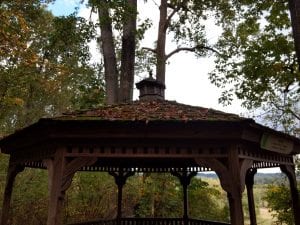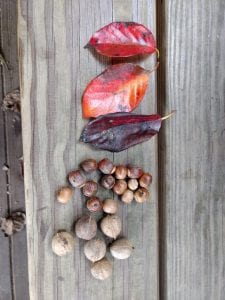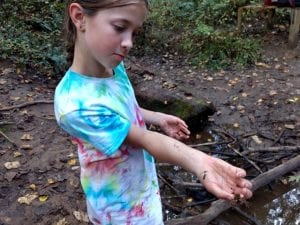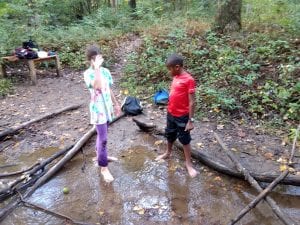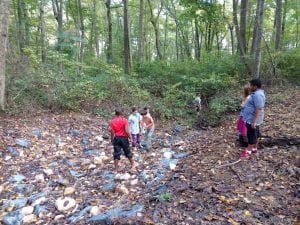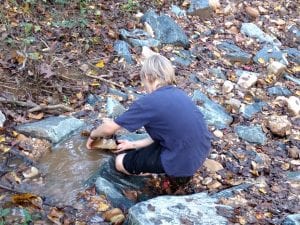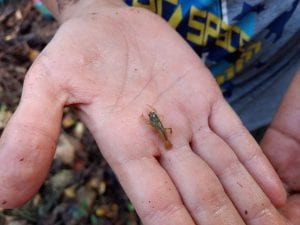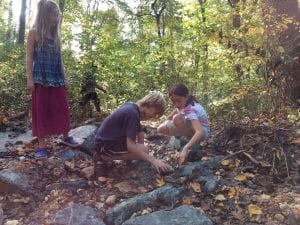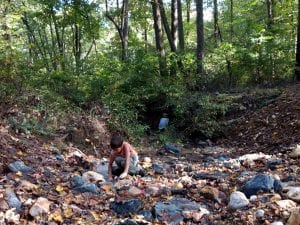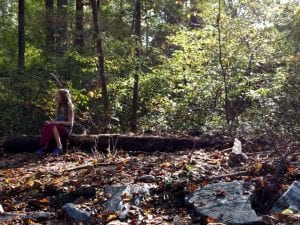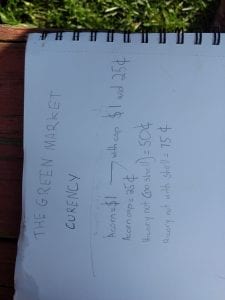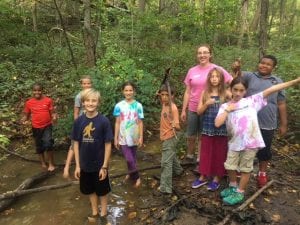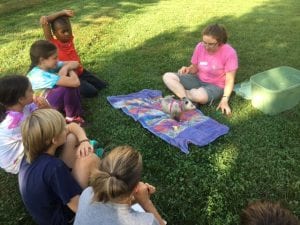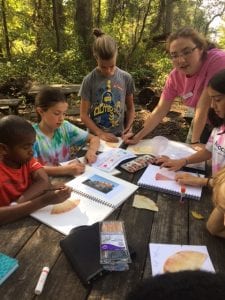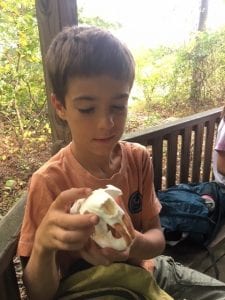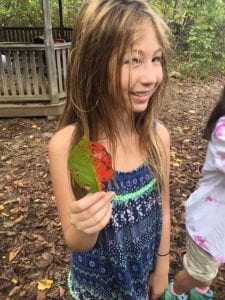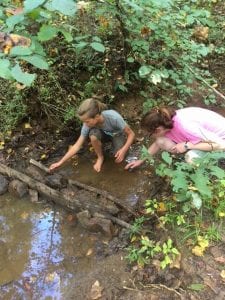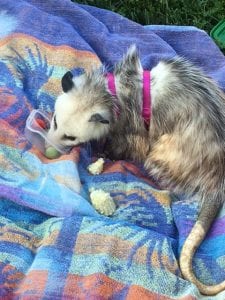October 10th, 2017
Today was all about using our nature engineering skills to build a dam and discover the best materials for dam building and put ourselves in the mind of a beaver. We started our afternoon by revealing our chlorophyll experiment from the previous week. We had collected leaves of different colors, torn them up into tiny pieces, put them in a cup with rubbing alcohol and a coffee filter and waited. The results are nature’s tie-dye with chlorophyll and other leaf pigments. We each got a piece of a coffee filter painted with leaf colors, put it in our journal and labeled the pigments. Green pigments are called chlorophyll and are created by chloroplasts in the leaf. As Fall and Winter approach the chloroplasts begin to shut down and die, no longer creating green chlorophyll. When this happens, other pigments that exists all along start to come to the forefront. The yellows are called flavonoids, the oranges are called carotenoids and the reds are called anthocyanins. It was also really neat how the different pigments layered themselves in the coffee filter.
After we all had documented our leaf experiment we headed to the gazebo for snack and to talk a bit about beavers, since they are the animals we were going to try to embody for today’s biomimicry class. Beavers are essentially nature’s engineers. They construct dams (most of the time) to create a safe environment for them to swim in, raise their young in, and to transport materials in. The water can’t be too deep and it can’t be too shallow so only certain types of creeks and streams are dammed up. The water also provides a large mote of sorts that protects the beaver family from predators. What are the benefits of these ponds these beavers create? Sometimes they can cause damage to property and structures that humans have created. This does pose a problem for the beaver since they are merely doing what they do best. Often times the beaver is relocated if their “ponding” endeavors interfere too much. But in general these wetlands that the beavers create are critical to the ecosystem. Not only are wetlands one of the most biologically diverse and productive habitats on Earth they provide a lot of benefits to people. They act as a filter for our water, they store water during floods and they provide food for people and animals. We were going to create a pseudo dam at one of our low flowing creeks (which would be taken apart the same day) to see just how beaver dams can work! I passed around a beaver skull and we briefly talked about how beavers are a rodent, which is a type of mammal, that has teeth that never stop growing. We talked about what beavers eat and what how they get food through the winter. Beavers cut down trees for their dams and lodges but they also store the food underwater in a cache (the cold water preserves the wood) and eat it through the winter.
On our way to the stream we had a great time creating a leaf market using nuts like acorns and hickory as currency to purchase leaves. I’m not sure who created the market but I do know that Audrey and Noa were the first ones to start it. It became a really fun game that the kids later named “The Green Market.” They all decided that an acorn = $1 and with a cap that acorn is worth $1.25. Just an acorn cap is $0.25. A hickory nut with no shell (husk) is $0.50 and a hickory nut with a shell (husk) is $0.75. It looks like those acorns are more valuable! You can see a picture of their currency they wrote down below in the gallery. Also near the gazebo we found a very large wholly bear caterpillar and counted the rings on the fallen oak tree. We briefly talked about why a tree makes rings and the different parts of a tree. The parts include the heartwood in the center, which is wood that isn’t alive but provides structure and support, the cambium, which is alive and is a very thin layer between the heartwood and the bark and then the bark itself which provides protection. We found out that oak tree was nearly 60 years old!
We continued on to the stream, collecting leaves to sell and buy in the market. At the stream we talked about the dam we were going to build. The water was very shallow, only an inch or two, and most of us didn’t believe it could get much deeper. James found a great place to build the dam and everyone agreed that building it at a narrow point would be the best option. I asked why and they said it was because they could use fewer materials. Smart and guess what, that is exactly how many dams are built 
More below…
We explored the new part of the stream and moved some smaller rocks around to experiment with the flow of the water and listened as the water rushed far under the rocks. We found more frogs and a couple crayfish, one was a tiny baby crayfish. We spent some time exploring the restored part of the creek before heading back to Irvine to meet a nocturnal mammal. Gathering on the grass we met our Virginia Opossum. Opossums are nocturnal marsupials that are native to Maryland. Some of their great features are they eat ticks and they eat a lot of them too! They also can play dead when they feel threatened and have a very useful prehensile tail which aids them in balance and grip and if they slip off a tree they’re climbing. Opossums, however, don’t use their tail to hang upside down and sleep. That would be like you hanging by your pinky fingers, ouch! We talked about where opossums live, what they eat and some of their adaptations, such as their great hearing, large whiskers and dark eyes to see at night. The opossum got a few grapes and grape tomatoes as a yummy treat for being such a great animal ambassador for us today!
- Gazebo in fall
- “Green Market” goodies
- Eva found a crayfish
- The stick Elias put down to mark the water
- Exploring the restored part of the stream
- Henry manipulating the water flow
- Baby crayfish!
- Audrey, Henry and Noa
- Lev looking at the water moving through the rocks
- Audrey resting on a log
- Currency for the “Green Market”
- Group photo by the dam
- Meet the Virginia Opossum
- Journaling with our chlorophyll art
- Lev with the beaver skull
- Audrey with a leaf for sale
- James and Mrs. Kelly building hte dam
- Opossum loves grape tomatoes and grapes





